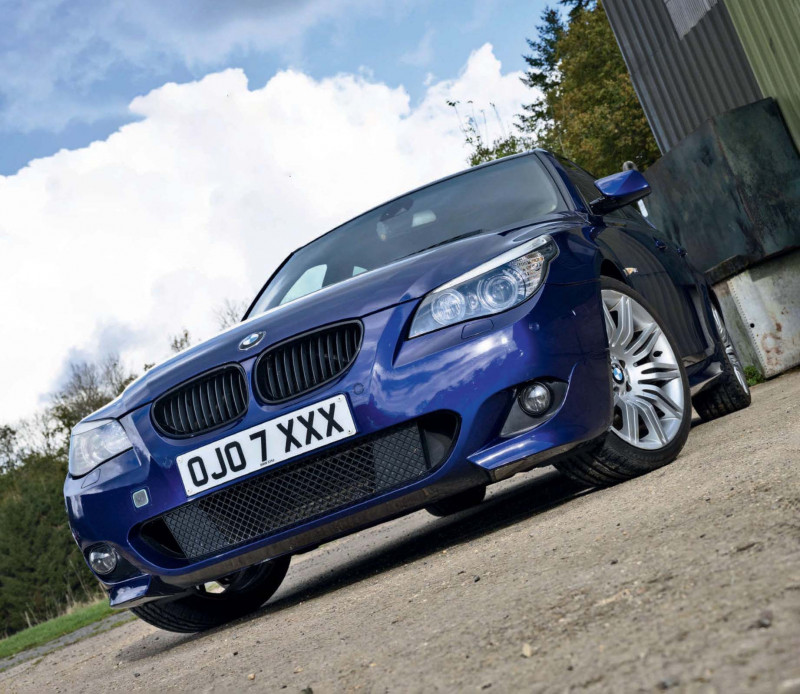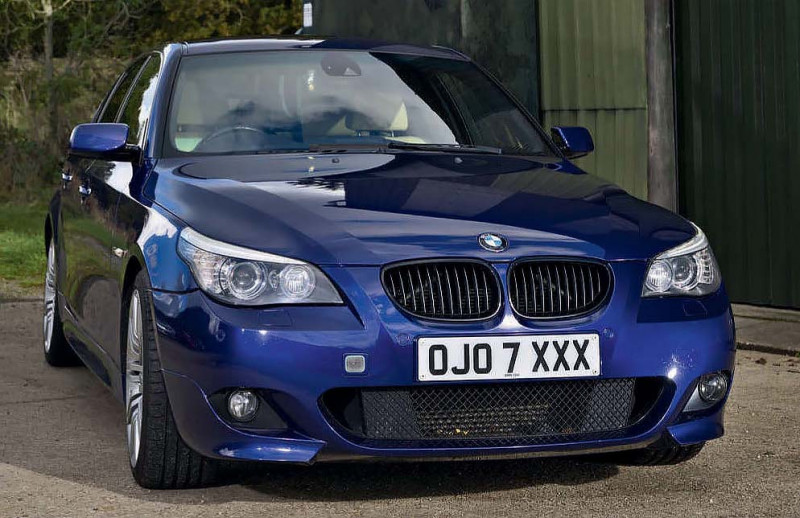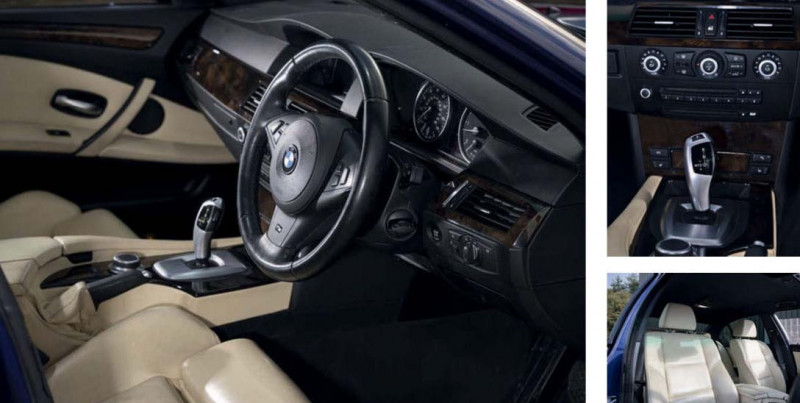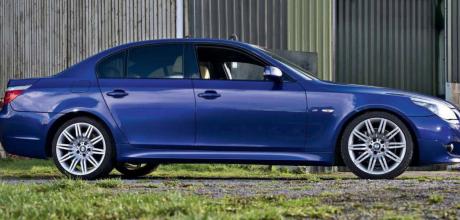2009 BMW 535d Automatic E60
There had been quick diesels before the E60 535d made its debut, but none of them had the breadth and depth of ability of BMW’s twin-turbo executive bruiser.
Words: Bob Harper
Photos: Jason Dodd
Original Sin
Performance diesels are commonplace nowadays, but when it came out, the E60 535d was seriously special.
The rise and fall of the diesel has been quite the phenomenon, rising phoenix-like from the HGV segment to be the darling of the company car set and then vilified for those nasty sooty deposits that we’ve all seen emanating from the exhausts of knackered clunkers. At the peak of its power, diesel-engined machinery accounted for almost 50% of UK car registrations, yet by 2022 diesel sales represented a smidgen over 5% of all new cars hitting the roads. During this hiatus, we also experienced a new genre of motoring, the performance diesel, two words that had never previously been used in the same sentence.

BMW had dabbled with diesel in both the E30 3 Series and the E28 5 Series, but these 2.5-litre six-cylinder engines were nothing to write home about, mustering 86hp in non-turbocharged form or a not-so-heady 115hp with the addition of a turbo. There were definite improvements in the 1990s, though, with the introduction of the 325tds and 525tds, with that ‘s’ indicating the addition of an intercooler. Praise started coming for BMW’s diesel models, with Autocar concluding during a comparison test between the E34 525tds and the 520i that: “The extra punch of the 525tds, its overall refinement, brisk performance and exceptional economy combine to make it the preferred choice.”
However, this was still the old M51 diesel mill, and it wasn’t until the debut of the M57 in the 330d and 530d that the BMW diesel really came of age and that the words performance and diesel could genuinely be uttered in the same breath. As well as increasing the valve count from two- to four-per-cylinder, the main advance was the adoption of common-rail direct injection at much higher pressures, which revolutionised BMW diesels. Along with the debut of the M47 four-cylinder, it proved to be a real game changer for BMW, and the diesel revolution continued apace. In 1995, only 13% of BMWs sold in the UK were diesels, yet by 2003 that figure had risen to 28%. In the 5 Series range, the shift was just as dramatic. In 2002, the E39 diesels made up 39% of all saloons and 56% of Tourings. And by the time the E60 generation arrived in 2004, 54% of saloons and an incredible 74% of Tourings used the smelly pump. Little wonder, then, that BMW went even further than the already excellent 530d.

The debut of the 535d really put the performance diesel on the map and secured BMW’s position as the purveyor of the best sporting saloons, no matter which pump they supped from. Driving a 535d for the first time was a real revelation, especially if you tried to make it difficult for the car. If you left it in manual mode and selected fifth gear at about 1300rpm, you knew what to expect from a diesel. This was their real weak spot, where the turbo had yet to join the party, and you’d be expecting a meeting to take place in the ECU where all parties had to hold a vote on whether to let it spool up or not. Once the votes had been counted and the motion had been passed, you could expect some forward momentum at some point that day.
Not so in the 535d, with the scenery immediately reversing at quite a rate as the car just muscled forward with no stress or strain. By the time you’d hit the sweet spot between three and four-five on the tacho, it seemed as if the car was trying to take off, and the speedo would be buried deep into three figures. But there was no let-up – even as the engine approached its 5000rpm limit, it was still pulling like a train. So, how did the 535d achieve such witchcraft? All turbo engines suffer from ‘lag’ – that wait while the turbocharger spools up from idle. Small, light-pressure turbos have less inertia, so produce less lag, but they don’t offer big performance gains, whereas a bigger turbo has more inertia, and more lag but gives greater performance up the rev range. The 535d offered the best of both worlds. At low engine speeds, a small turbo gave almost instant urge.

19” 172M ‘Spider’ alloys still look great; LCI 535d made 286hp and 428lb ft of torque.
As engine speeds rose, the small turbo was at full capacity, and the big turbo was pre-spooled and phased in to further increase the amount of air being pushed into the engine. At high revs, the big turbo took over.
The 535d achieved its maximum output of 272hp at 4400rpm, and its rev limit was 500rpm higher than the single-turbo 530d. Yet it produced 95% of its 413lb ft of torque at just 1500rpm, while peak twist came in at 2000rpm. It was this breadth of performance that destroyed your preconceptions.
It was quite simply awesome. Usually, on-paper figures don’t really do justice to the ‘real world’ performance of a well-sorted diesel, but for once, the stats really did show what this car was capable of: 0-62mph in 6.5 seconds and a top speed limited to 155mph. Those performance figures would have given an E34 M5 a run for its money, one of the all-time great super-saloons. Of course, you’d pay the penalty at the pumps, right? Wrong: the 535d returned over 35mpg on the combined cycle, just 2% less than the 530d.
BMW has never been one to rest on its laurels, though, and behind the scenes, it was busy tweaking the 535d’s spec to make it an even finer machine in its facelift guise. Power and torque were both up – now 286hp and 428lb ft – gains of 14hp and 14lb ft, yet economy was improved by 17.5% to 41.5mpg.

E60 interior still feels luxurious and looks smart.
The engine revisions helped, but there was also a healthy dose of BMW’s then-new EfficientDynamics measures, as well as a new gearbox. All 535ds were equipped with a six-speed auto, but in the LCI model it featured upgraded hydraulics, an innovative new torque converter and more powerful software, and BMW claimed the new automatic ’box responded 50% quicker than the previous unit.
There was more to the 535d than its excellent drivetrain, though, as it looked good and drove well, too. Perhaps a little dowdy in non-Sport guise, but the addition of the M Sport kit had a transformative effect on the car. It looked every bit the junior M5, with its more aggressive front and rear bumpers, larger alloys and subtly lowered stance. Inside, the Sport seats gripped you well, and there were plenty of the normal M-lite accoutrements to remind you that this was something a little special. Standard equipment was pretty generous, and there were a plethora of options to choose from, ranging from Dynamic Drive and Active Steering to a Head-up display and Night Vision.
On the road, the 535d was a proper driving tool, although with a smattering of suspension components from the M5, 18” alloys and runflat rubber, its ride could be a little firm for some owners, especially on the UK’s crumbling blacktop. However, when the road surface doesn’t look like the pock-marked surface of the moon, it was very well sorted – firm and tautly suspended but supple enough. It had simply immense levels of dry grip, allowing corner speeds that initially seem ambitious but, in fact, rarely trouble the electronic stability programs. Switch them out, and with that much torque, it was easy enough to overwhelm the back tyres, but it never felt anything other than composed.
But how does the 535d stack up today? We spoke to Don Wearing, a serial BMW owner who bought his first back in 1981 and whose stable has included machinery such as an E23, E24, a V12 E38, three E39 M5s, an E60 M5, a 28k-mile 850CSi, an M6 and a 30 Jahre F10 M5. Safe to say, he knows his onions when it comes to BMWs. His example is a BMW Individual machine finished in Velvet blue with a Champagne interior, and it’s an LCI model dating from 2007. “We bought it when it was three years old, so in 2010, which means we’ve owned it for 13 years, now. It’s my wife who mainly uses it; she doesn’t do many miles, and she loves the colour configuration, and it’s an easy thing to drive being an automatic. Every time I suggest upgrading it for something newer she refuses, which saves me money!” he says with a laugh.
Don praised its effortless performance, which in the case of his car, is a little better than standard as it was chipped soon after he bought it courtesy of Superchips in Buckingham. Power is now up in the region of 350hp, and torque has swelled to around 500lb ft, so it really does go well. “It’s a bit of a sleeper,” says Don, “it’s not quite in M5 territory, but it does dig down and get a real move on. It’s still a great performance car.”
It’s also been utterly reliable, no doubt in part due to its low mileage, as Don recounts. “It had done about 38,000 miles when we bought it, but it’s only on 65k now, so it’s not covered a huge number of miles. It’s never been problematic – it’s had normal maintenance like discs and pads all-round, and sets of tyres along with regular servicing, but it’s had an easy life. I’ve had BMWs since 1981, and it’s the most reliable one I’ve ever had! I’ve not had to fit a starter motor or water pump, or an alternator, it’s never even lost its gas in the air con! Inside the exhausts, it’s as clean as a new sixpence, so the EGR and particulate filters are obviously working just fine. The only thing that has just started to happen is that the offside front headlight has just started to delaminate a little and let some water in. I think it comes from a time when BMW put a little bit more quality into their cars – the more recent ones seem to be less wellbuilt and constantly have warning lights coming up on the dash! The 535d has been very good.”
The E60 generation 535d might be coming up to its 20th birthday, but as Don attests, it’s still a great machine to drive and own. Its twin-turbo technology really moved the game on when it came to performance diesels, and it’s a crying shame that the genre has died out, even though the latest generation of Euro 6d diesels are incredibly clean. We’ll leave the last word to Don: “The E60 has become a bit of an icon now… When you see one today with the M Sport kit on it, I think they look super. It’s aged really well, and the 535d was quite the brilliant all-rounder”.
TECHNICAL DATA E60 535d 2004-2007
- ENGINE: 3.0-litre twin-turbo diesel straight-six M57D30TÜ
- MAX POWER: 272hp @ 4000rpm
- MAX TORQUE: 413lb ft @ 2000rpm
- 0-62MPH: 6.5 seconds
- TOP SPEED: 155mph (limited)
- ECONOMY: 35.3mpg
- EMISSIONS (CO2): 211g/km
- WEIGHT: 1735kg
- PRICE: £39,200 (2005)
TECHNICAL DATA E60 535d LCI 2007-2010
- ENGINE: 3.0-litre twin-turbo diesel straight-six M57D30TÜ2 TOP
- MAX POWER: 286hp @ 4400rpm
- MAX TORQUE: 428lb ft @ 1750-2250rpm
- 0-62MPH: 6.4 seconds
- TOP SPEED: 155mph (limited)
- ECONOMY: 41.5mpg
- EMISSIONS (CO2): 182g/km
- WEIGHT: 1735kg
- PRICE: £42,165 (2007)
When you see one today with the M Sport kit on it, I think they look super. It’s aged really well, and the 535d was quite the brilliant all-rounder


